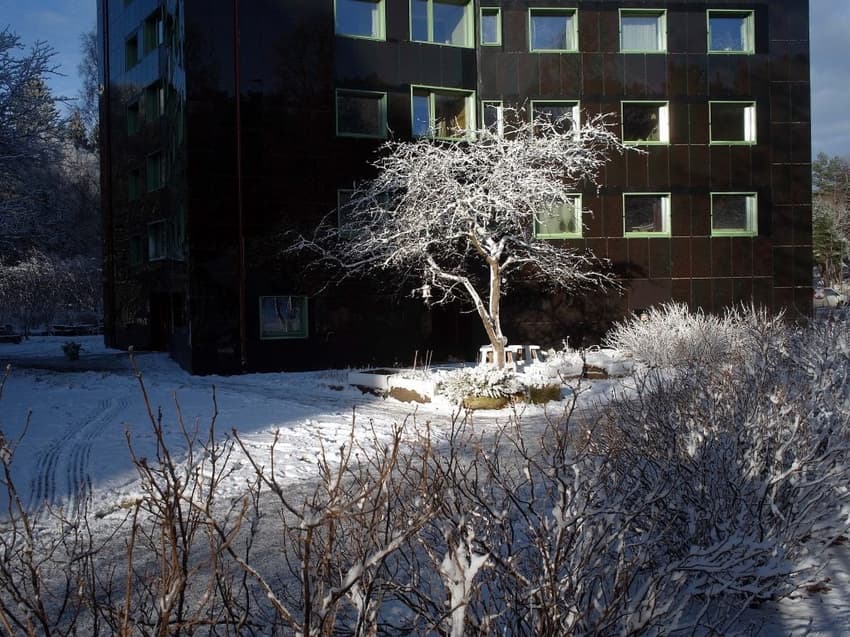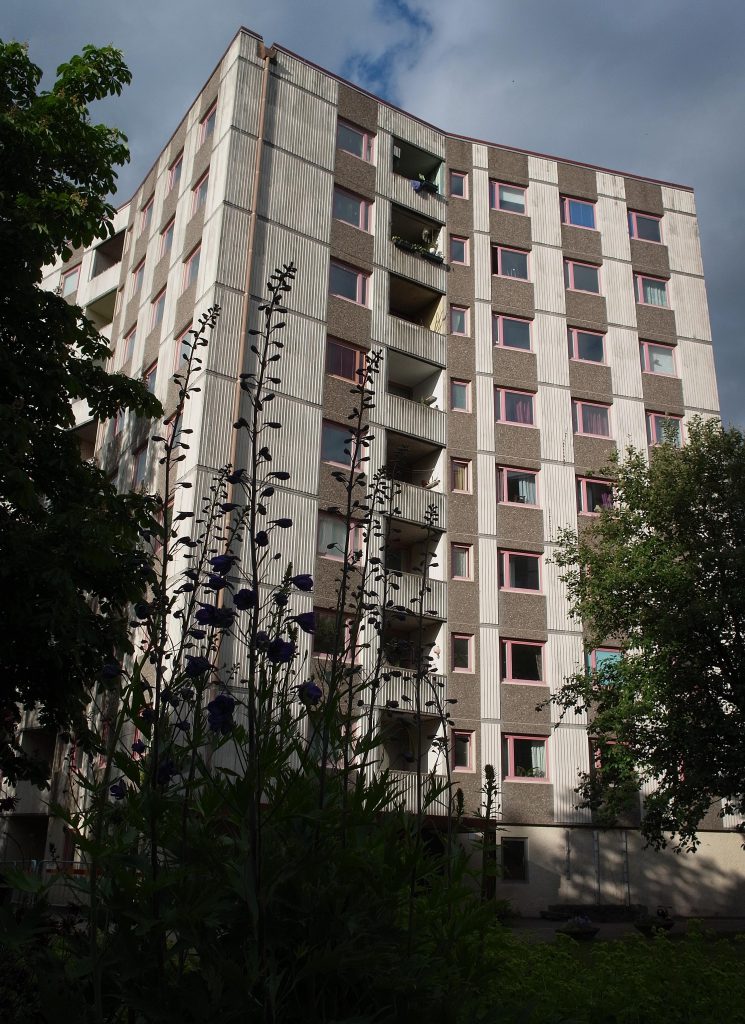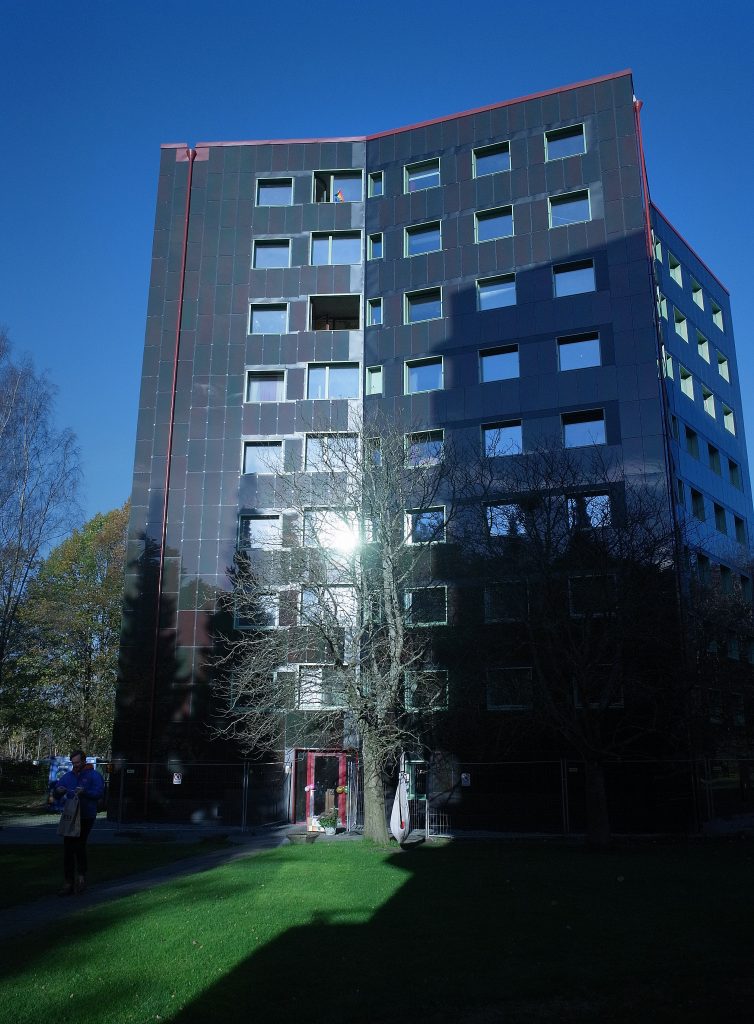The story behind a 1960s high-rise turned 'passive house' in Gothenburg

Residents of a so-called 'million programme' apartment complex from the 1960s in Gothenburg have collectively turned the building into an energy-efficient home, where energy needed to heat the building has decreased by 90 percent.
In the north-eastern tracts of Gothenburg, near the terminus of tramline 11, stands a row of near-identical apartment buildings against the backdrop of the forest. Nine high-rises of eight floors each, in an unmistakable 1960s style.
Yet one of the buildings seems out of place.
The last in line, at Teleskopgatan 2: in contrast to the cream-white and beige façades of the other buildings, this one is a mirrored black. Come closer and you’ll see that the entire facade — all sides of the star-shaped building, plus the flat roof — is covered with what looks like a wallpaper of solar panels.
The solar cell house is not the brainchild of a visionary 1960s architect who had grown tired of the era’s pragmatic designs. The property has recently undergone a transformation, initiated by its residents, having grown tired of their shell.
The multitude of 1960s flats arose as part of the Swedish Miljonprogrammet or 'Million Programme', when the influx of migrant workers some half a century ago led to a pressing housing shortage.
The government set out to build a million affordable apartments within a decade, a decision that led to the creation of completely new neighbourhoods, usually on the outskirts of cities, with the dime a dozen high-rises like the one in this neighbourhood, Bergsjön.
But the construction fever turned out to be more extensive than housing demand. In the mid-1970s, a large number of the newly created apartments stood vacant.
The then-owner of Teleskopgatan 2, the housing association Göteborgshem, thought it a good opportunity for an experiment. What would happen if the apartments on the fifth flour were replaced by a communal kitchen, dining room and daycare? Then they could turn this entire building into a collective.
And so it happened. In 1980, the first tenants moved into Kollektivhus Stacken (The Stack) and soon all 35 apartments in the collective were occupied.
When, around the turn of the century, Göteborgshem wanted to sell the complex, the residents decided to create a 'cooperative tenants' rights association'. The association took over the ownership of the property and the approximately 60 residents all became members in the cooperative. From now on they would collectively manage the future of their Stacken.

The building before the transformation. Photo: Annika Söderlund
They established a democratically elected residents' council that would concern itself with major decisions and plans for the future. Various working groups were set up to promote solidarity and to reduce the recurrent, monthly costs. Each adult member of the collective was expected to do three hours of communal work a week: in the garden team, for example, the cleaning team, the café team, the communication team, the babysitting team.
Several residents founded the ‘electricity group’. Its members would review the collective’s energy usage and potential energy savings, hoping to cut bills — and in the same breath make environmental gains.
With the approval of the board, the working group hired an energy consultant who produced a modest report on options for energy conservation: better insulation of the attic and a so-called ‘heat recovery ventilation’ (HRV), a ventilation system which, well, recovers heat. The heat produced by the residents — through their body temperatures and by cooking, for example — is captured and used to heat the fresh air in the ventilation system.
"When I moved to Stacken about ten years ago, the HRV system had just been installed and a company was busy insulating the top floor," remembers former resident Dan-Eric Archer. Archer, who himself was schooled in energy system engineering, naturally joined the collective’s energy team.
But the group wanted more. Soon after the moderate energy saving interventions, they conceived a plan for a larger-scale project, which would change the whole face of Stacken and transform the sixties building into a passivhus, a so-called 'passive house' or ultra low-energy building. The project was unprecedented, not only due to Stacken's age -- the term 'passive house' usually refers to new buildings -- but also because the transformation was initiated and orchestrated by its residents.
The regulations for a 'passive building' include energy savings of 90 percent compared to the original design (or 75 percent of regular, new constructions), the use of internal heat sources such as an HRV system, the insulation of all external walls and the replacement of the windows.
All in all a major job, and without any example to follow. Every decision, moreover, had to be taken democratically.
Ultimately it was Archer who came up with the idea to cover the entire exterior with solar cells. "We had to cover the new insulation layer with something. I found a dirt cheap load of solar cells at a German broker who sells second-hand panels. They were from a company that had recently declared bankruptcy. The panels were unused and cost more or less the same as conventional covering material.”

The collective house after the transformation. Photo: Annika Söderlund
Financing the project was not even the hardest part. The collective received a loan from a Swedish bank and were granted about a third of the total amount of 12.5 million kronor in subsidies. The region, the national energy authority, environmental conservation groups all wanted to be part of this ground-breaking project.
Finding a contractor turned out to be a far greater hurdle. "We asked over thirty companies," says Archer. "But there are so many construction projects going on. Most of them were fully booked." Others deemed the job too risky; no one, after all, had done this before.
Finally, they found a company willing to help. The contract was signed in May 2016. "It was supposed to take five months. It turned out to be a year and a half." And not without conflict: the collective was dissatisfied with the quality and had to redo part of the work itself. They refused to pay the entire bill, which resulted in a lawsuit. Archer shrugs: that’s what happens with projects of this scope and nature.
But the result is impressive: the energy needed to heat the building has decreased by 90 percent since the installations of the new windows, insulation and the HRV system. The generated solar power equals 90 percent of the annual energy consumption.
"Even the minority of residents who have always voted against the passive house project are proud now," says Archer.
And can Stacken's example be replicated? "Certainly," he says. "Everyone should do this."
Comments
See Also
In the north-eastern tracts of Gothenburg, near the terminus of tramline 11, stands a row of near-identical apartment buildings against the backdrop of the forest. Nine high-rises of eight floors each, in an unmistakable 1960s style.
Yet one of the buildings seems out of place.
The last in line, at Teleskopgatan 2: in contrast to the cream-white and beige façades of the other buildings, this one is a mirrored black. Come closer and you’ll see that the entire facade — all sides of the star-shaped building, plus the flat roof — is covered with what looks like a wallpaper of solar panels.
The solar cell house is not the brainchild of a visionary 1960s architect who had grown tired of the era’s pragmatic designs. The property has recently undergone a transformation, initiated by its residents, having grown tired of their shell.
The multitude of 1960s flats arose as part of the Swedish Miljonprogrammet or 'Million Programme', when the influx of migrant workers some half a century ago led to a pressing housing shortage.
The government set out to build a million affordable apartments within a decade, a decision that led to the creation of completely new neighbourhoods, usually on the outskirts of cities, with the dime a dozen high-rises like the one in this neighbourhood, Bergsjön.
But the construction fever turned out to be more extensive than housing demand. In the mid-1970s, a large number of the newly created apartments stood vacant.
The then-owner of Teleskopgatan 2, the housing association Göteborgshem, thought it a good opportunity for an experiment. What would happen if the apartments on the fifth flour were replaced by a communal kitchen, dining room and daycare? Then they could turn this entire building into a collective.
And so it happened. In 1980, the first tenants moved into Kollektivhus Stacken (The Stack) and soon all 35 apartments in the collective were occupied.
When, around the turn of the century, Göteborgshem wanted to sell the complex, the residents decided to create a 'cooperative tenants' rights association'. The association took over the ownership of the property and the approximately 60 residents all became members in the cooperative. From now on they would collectively manage the future of their Stacken.

The building before the transformation. Photo: Annika Söderlund
They established a democratically elected residents' council that would concern itself with major decisions and plans for the future. Various working groups were set up to promote solidarity and to reduce the recurrent, monthly costs. Each adult member of the collective was expected to do three hours of communal work a week: in the garden team, for example, the cleaning team, the café team, the communication team, the babysitting team.
Several residents founded the ‘electricity group’. Its members would review the collective’s energy usage and potential energy savings, hoping to cut bills — and in the same breath make environmental gains.
With the approval of the board, the working group hired an energy consultant who produced a modest report on options for energy conservation: better insulation of the attic and a so-called ‘heat recovery ventilation’ (HRV), a ventilation system which, well, recovers heat. The heat produced by the residents — through their body temperatures and by cooking, for example — is captured and used to heat the fresh air in the ventilation system.
"When I moved to Stacken about ten years ago, the HRV system had just been installed and a company was busy insulating the top floor," remembers former resident Dan-Eric Archer. Archer, who himself was schooled in energy system engineering, naturally joined the collective’s energy team.
But the group wanted more. Soon after the moderate energy saving interventions, they conceived a plan for a larger-scale project, which would change the whole face of Stacken and transform the sixties building into a passivhus, a so-called 'passive house' or ultra low-energy building. The project was unprecedented, not only due to Stacken's age -- the term 'passive house' usually refers to new buildings -- but also because the transformation was initiated and orchestrated by its residents.
The regulations for a 'passive building' include energy savings of 90 percent compared to the original design (or 75 percent of regular, new constructions), the use of internal heat sources such as an HRV system, the insulation of all external walls and the replacement of the windows.
All in all a major job, and without any example to follow. Every decision, moreover, had to be taken democratically.
Ultimately it was Archer who came up with the idea to cover the entire exterior with solar cells. "We had to cover the new insulation layer with something. I found a dirt cheap load of solar cells at a German broker who sells second-hand panels. They were from a company that had recently declared bankruptcy. The panels were unused and cost more or less the same as conventional covering material.”

The collective house after the transformation. Photo: Annika Söderlund
Financing the project was not even the hardest part. The collective received a loan from a Swedish bank and were granted about a third of the total amount of 12.5 million kronor in subsidies. The region, the national energy authority, environmental conservation groups all wanted to be part of this ground-breaking project.
Finding a contractor turned out to be a far greater hurdle. "We asked over thirty companies," says Archer. "But there are so many construction projects going on. Most of them were fully booked." Others deemed the job too risky; no one, after all, had done this before.
Finally, they found a company willing to help. The contract was signed in May 2016. "It was supposed to take five months. It turned out to be a year and a half." And not without conflict: the collective was dissatisfied with the quality and had to redo part of the work itself. They refused to pay the entire bill, which resulted in a lawsuit. Archer shrugs: that’s what happens with projects of this scope and nature.
But the result is impressive: the energy needed to heat the building has decreased by 90 percent since the installations of the new windows, insulation and the HRV system. The generated solar power equals 90 percent of the annual energy consumption.
"Even the minority of residents who have always voted against the passive house project are proud now," says Archer.
And can Stacken's example be replicated? "Certainly," he says. "Everyone should do this."
Join the conversation in our comments section below. Share your own views and experience and if you have a question or suggestion for our journalists then email us at [email protected].
Please keep comments civil, constructive and on topic – and make sure to read our terms of use before getting involved.
Please log in here to leave a comment.